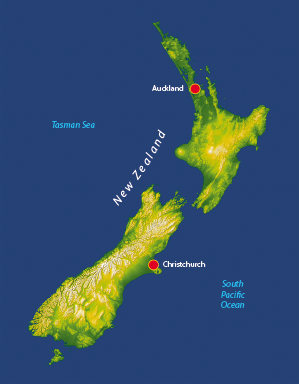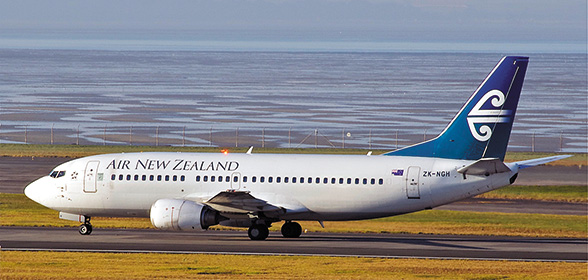
A Boeing 737 captain’s check-ride anxiety — combined with stress over health issues and an earthquake and its associated aftershocks — was so unnerving that he “compromised the safety of the flight” during an approach to Christchurch, New Zealand, accident investigators say.
The New Zealand Transport Accident Investigation Commission (TAIC), in its final report on the Oct. 29, 2011, incident, said that the captain “did not make the appropriate response to two automated calls prior to the aeroplane reaching the point (decision height) at which the flight crew needed to decide whether to continue and land or initiate a missed approach” and that the first officer did not challenge him for an appropriate response.
The captain then failed to initiate a missed approach at decision height despite weather conditions unsuitable for landing “probably because he was operating under a level of stress where anxiety was interfering with his cognitive functioning,” the report said.
None of the 134 people aboard the airplane was injured, and the airplane was not damaged in the incident, which occurred at 0810 local time, at the end of a 70-minute flight from Auckland.
When the Air New Zealand flight left Auckland at 0700 — with the check captain aboard to conduct the captain’s annual route check — the forecast was “favourable for a successful landing” in Christchurch, the report said. Conditions deteriorated en route and included a forecast of periods of 1,500-m (less than 1 mi) visibility with broken clouds at 200 ft.
At 0742, before beginning the descent, the flight crew listened to the current Christchurch automatic terminal information service (ATIS) weather information, which included visibility of 6 km (4 mi), lowering to 2,000 m (1.25 mi), and a 300-ft overcast, and the captain briefed the first officer for the arrival route and instrument landing system/distance measuring equipment (ILS/DME) Category I approach to Runway 02.

“For the Boeing 737, this permitted a descent to a decision height of 200 feet above the runway threshold,” the report said. “The minimum visibility required to land was 800 m [about one-half mile]. The arrival procedure and ILS/DME approach were to be flown using the autopilot. The approach briefing also included the missed approach procedure to be followed. … The approach was to be flown in accordance with the operator’s standard ‘monitored approach’ procedure, which meant the captain was flying and would look outside the cockpit approaching the decision height while the first officer had his head down monitoring the instruments.”
At 0808, the airport tower air traffic controller told the flight crew that the 737 was behind an ATR 72, also on the ILS/DME approach, that the clouds had “descended to the ground now” and that visibility was 800 m. The controller added that a late landing clearance was likely to allow the ATR time to clear the runway.
As the 737 descended to 1,000 ft above the runway threshold, an automated voice made the “one thousand” callout. The airline’s procedures required the pilot flying to respond by saying either “stable” or “go around,” but the captain “made no response … although the check captain believed he heart him ‘grunt,’” the report said.
Neither the captain nor the first officer verified the grunt, the report said, adding that the first officer had said the captain’s lack of response “was not unexpected.” Although the first officer had not flown with the captain before, he was “aware of his reputation for not being overly communicative,” the report said.
When the airplane was 300 ft above the threshold and the automated “plus 100” call was made, the captain should have responded by saying “confirmed.” Neither the first officer nor the check captain heard the response, although the captain told investigators that he thought he had said something.
The first officer told investigators that he was about to prompt the captain for a response when the pilots heard a third automated call — “minimums” — to which the captain should have responded either “continue” or “go around.” The captain said neither and later said that he had been looking at the instruments as the airplane neared decision altitude; when he heard the “minimums” call, he looked up and was surprised and confused that he could not see the runway environment.
“The first officer repeated the ‘minimums’ call,” the report said. “He then looked across at the captain to check if he was still actively flying. The captain appeared okay, so the first officer then looked forward, expecting to see the runway ahead, but all he could see was cloud.”
Later, the first officer said he was again about to prompt the captain — and the check captain said he was about to intervene — when the runway approach lights became visible.
“The aeroplane was estimated to be about 100 feet above the runway at this time,” the report said. “The captain disconnected the autopilot and landed the aeroplane without any word.”
After the landing, and after the airplane was taxied in and shut down, the check captain told the captain that he had failed the check flight.
The report noted that flight crews of the next two airplanes on the approach both declared missed approaches.
The 68-year-old pilot had accumulated 23,875 flight hours, including 7,210 hours in 737s. He held an airline transport pilot license (ATP) and had worked for the operator for 47 years, first becoming a captain in 1974. He began flying in international operations in 1989 and was a 747-400 captain, but in 2003, because of U.S. age restrictions that barred pilots after they turned 60, he transferred to the 737 fleet. The captain’s age was not a factor in the incident, the report said.

In the days before the incident, the captain had been off on Oct. 25 and 26, flown for 3.1 hours on Oct. 27 and spent a day in classroom emergency procedures refresher training on Oct. 28.
The first officer, 43, had 8,420 flight hours, including 2,320 in 737s, and held an ATP. He had not worked the day before the incident and said he was well rested, with “no personal issues that might have affected him” during the flight. He first met the captain at their preflight briefing.
The check captain, 49, had 17,200 flight hours, including 9,200 hours in 737s. He held an ATP, had begun working for the operator in 1995 and had been a flight examiner since 2006.
All three pilots said that they had slept about eight hours the night before the incident and that fatigue was not a factor. All were familiar with the ILS/DME approach to Christchurch.
Failure to Comply
The TAIC report said that the captain and first officer failed to comply with Air New Zealand’s standard operating procedures, which called for a monitored approach to the runway in poor meteorological conditions, and that this failure “eroded safety margins built into the procedures.”
When the captain failed to respond to the 1,000-ft call and the first officer did not prompt him for a response, neither the first officer nor the check captain was concerned “because they were aware that the aeroplane was on a stable approach,” the report said. “The first officer, however, should have prompted the captain, because the operator’s procedures required the captain’s lack of response to be challenged. This was the first breakdown in crew communication in that noncompliance with standard operating procedures went unchallenged.”
Soon afterward, when the captain failed to acknowledge the “plus 100” call and the first officer again failed to prompt him for a response, their failures were more serious, the report said, noting that the airplane was so close to decision height.
Seconds later, when the captain did not respond to the “minimums” call, the report said, “the first officer did not know if the captain was visual with the runway environment, or even if the captain was still in control of the aeroplane. The first officer therefore repeated the ‘minimums’ call, then had to turn towards the captain to check on him before looking forward to see if they were actually visual.”
The report said that, when the “plus 100” call was made, the captain had been looking at the flight instruments instead of outside the airplane to see the runway as soon as possible.
When the airplane reached decision height and the captain looked outside for the first time and did not see the runway, he was “unable to react as required and commence an immediate missed approach,” the report said.
Earthquake Concerns
During interviews with accident investigators, the captain mentioned health issues and the 2010 earthquake centered near Christchurch, with aftershocks that continued into 2011, and said that both situations contributed to the stress he was experiencing at the time of the incident. A TAIC medical adviser said that the captain’s medical records did not mention stress issues, “and nothing else was evident that might have affected his ability to fly an aircraft.”
The captain also theorized that he might have been affected by continuation bias (also called target fixation), which the report defined as “a natural inclination to achieve a target or goal because [affected individuals] either want to or simply assume they can. If the inclination is strong enough in an individual, they will press on, even though changing circumstances might make achieving the goal difficult or unlikely.”
‘Minimalistic’ Communicator
The report said the captain’s communication style “could have been described as minimalistic, not wishing to promote interactive communication” and noted his “reported reputation within the company for saying little on the flight deck.”
The captain’s communication style and reputation “could well have contributed to the observed breakdown in the communication loop during the approach to Christchurch,” the report said. “It could also explain why the first officer was unwilling to challenge the lack of response to the 1,000-feet call.”
‘Enduring … Traits’
Nearly two years after the incident, TAIC asked an industrial psychologist to examine the event’s human factors components. The psychologist interviewed the captain, focusing not on the events surrounding the incident but instead on “enduring human performance traits that would be present.”
The psychologist said that he attached more importance to stress, and less to continuation bias, as a contributor to the incident. Continuation bias typically occurs when information needed to make a decision is unavailable or ambiguous, he said, adding that, in this case, the crew had information about the deteriorating weather conditions.
“The psychologist considered the captain was operating under a relatively high level of stress during the check flight, which was limiting his ability to perceive and react appropriately to tasks other than the immediate control of the aeroplane,” the report said.
The psychologist conceded that the pilot’s concern with his health issues and the ongoing earthquake aftershocks “could have been a factor” in his in-flight stress, the report said, “but when reviewing his longer history, [the psychologist] thought it more likely that the captain’s natural tendency to worry, exacerbated by his activities on the previous day (undergoing classroom emergency procedures refresher training and assessment) and the fact that he was undergoing a route check, were reasons for his not reacting appropriately during the instrument approach.”
The report said that, although the check captain and the first officer said that the routine check flight did not influence flight deck dynamics, “the psychologist’s opinion was that from this captain’s perspective, the check flight changed the normal dynamics. … From his perspective, the check captain was there to assess his performance, and this placed additional ‘evaluative stress’ on the captain, who did not enjoy such exercises.”
The report said evaluative stress involves “the focus of an individual … on how they are doing rather than what they are doing. This can introduce a layer of internal mental monitoring (continual self-assessment) that can, in extreme cases, cause mental blanks and acute anxiety to actively interfere with the primary task.”
The captain’s discomfort in this situation may have been, in part, a result of a previous check ride with the same check captain — a flight that the captain had described to the psychologist as “not … a relaxing experience.”
The report noted that check rides “were not new to the captain,” who had undergone 47 previous route checks and 94 simulator proficiency checks during his 47 years with the company.
“So how did this route check differ from the previous 47?” the report asked. “There are four factors that probably added to the stress the captain was under at the time:
- “His dislike for having his performance evaluated;
- “His past experience involving the same check captain, which from the captain’s perspective was a negative experience;
- “The particular circumstances of this approach and landing in marginal weather conditions; [and,]
- The other stressors he mentioned regarding his health and his response to the aftershocks to the Christchurch earthquakes.”
Defining Boundaries
Although the first officer should have challenged the captain’s failure to respond to the automatic calls, the psychologist said that the check captain’s presence on the flight deck might have influenced the first officer’s actions.
“The psychologist was of the opinion that any first officer faced with the captain’s uncommunicative style, in a similar situation could have found themselves having to determine the boundaries of their involvement,” the report said. “Stepping in too early to take corrective action or waiting too long for the captain to respond to a call may have been resented by the captain or seen by the check captain as interfering with the check process. In other words, because the two pilots were meant to act as a team, the first officer’s performance could be perceived as affecting the assessment of the captain’s performance.”
‘Above Average’
The TAIC report said that records maintained by the operator and by the New Zealand Civil Aviation Authority (CAA) showed that the captain had typically performed well in previous check situations, including comments of “above average check” and “cockpit management is to a high standard.” The report added, however, that “there was some critical comment regarding the use of nonstandard communications.”
Those comments included three operational occurrence reports in which a ground staff person — who had filed similar complaints about other pilots — discussed “the use of nonstandard communications during push-back.” The captain said that, after each of the three complaints, he had received “informal verbal follow-up action” from the 737 fleet manager or a representative.
Each time, although the captain acknowledged his error and agreed to try to use standard phraseology, his methods did not change, the report said, adding that when he was interviewed after the incident, “he said that he continued to believe that much of the phraseology was unnecessary.”
The report said that the TAIC also had received “anecdotal evidence from Air New Zealand pilots and other employees that the captain had a reputation for saying little to other pilots whilst flying, and abbreviating or omitting items from checklists.”
Company policy called for a “just culture” investigation in response to any report of procedural non-adherence to determine what prompted the deviation from procedures, but the report said that the process was not followed in the cases involving the captain.
“The lack of formal action … had two possible effects,” the report said. “Firstly, it could have showed a tacit acceptance of the captain’s tendency to not conform with standard communication procedures. Secondly, the captain himself could have believed that he did not have to make any constructive efforts to change the way he operated.”
Because of the incident, the airline developed a performance-management plan for the captain, the report said, “but he retired before it could be put into action.”
Potential for Altered Dynamics
The presence of a check captain has the potential to alter flight deck dynamics, and “it is important that this situation be managed,” the report said.
The report said that the airline has used the incident “to reinforce to its pilots the need to follow standard operating procedures.” In addition, the TAIC recommended that the CAA “highlight to other operators the need to follow procedures and to appropriately manage those situations where the normal crew dynamics may be disrupted by the inclusion of additional personnel, for example, during a check flight.”
This article is based on TAIC Final Report: Aviation Inquiry 11-007, “Descent Below Approach Minimums; Christchurch International Airport; 29 October 2011.” Approved for publication June 2014.
Featured image: © digitalista | Bigstock
Accident location map background: U.S. National Aeronautics and Space Administration
Accident aircraft: Aero Icarus | Wikimedia CC-BY-SA 3.0
